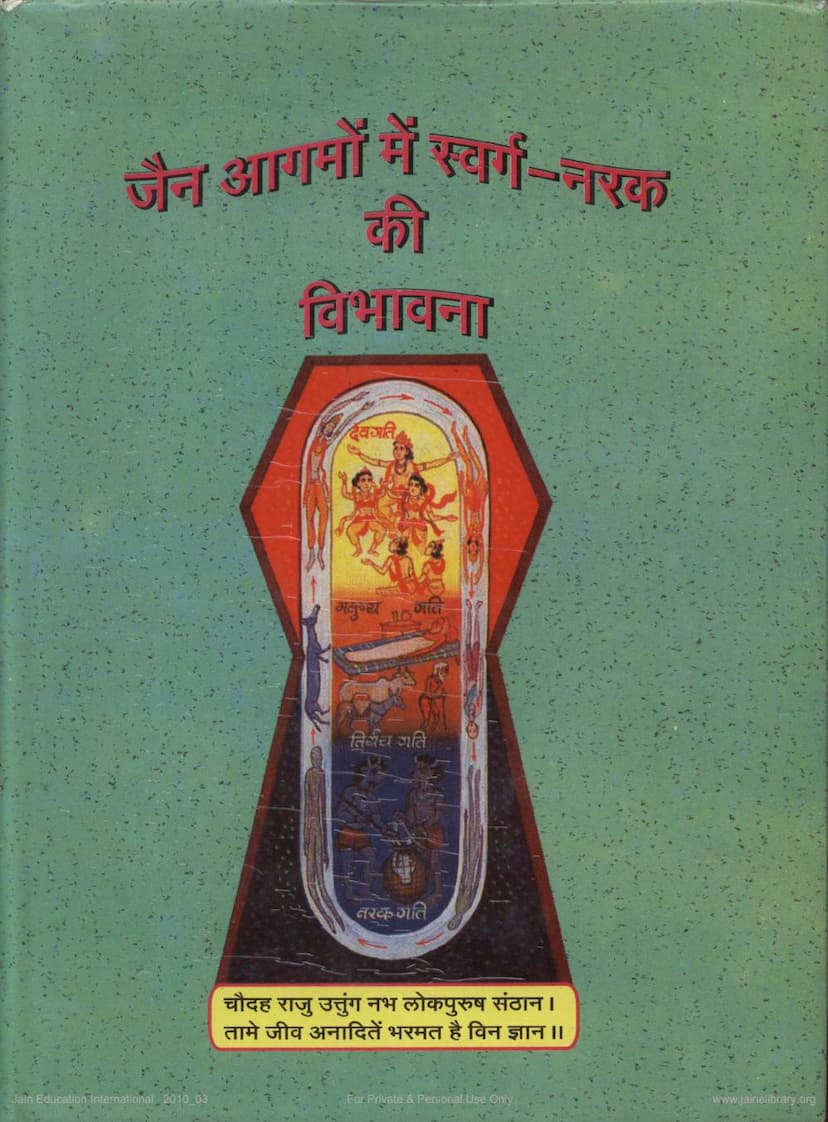Jain Agamo Me Swarg Narak Ki Vibhavana
Added to library: September 1, 2025

Summary
The book "Jain Agamo me Swarg Narak ki Vibhavana" (The Conception of Heaven and Hell in Jain Agamas) by Sadhvi Dr. Hemrekha Shri, published by Vichakshan Prakashan Trust, is a comprehensive exploration of the Jain perspective on celestial and infernal realms. The text delves into the scriptural descriptions and philosophical underpinnings of these concepts within Jainism.
Here's a summary of the key themes and content presented in the book, based on the provided pages:
Core Jain Concepts:
- Soul and Karma: The book begins by establishing fundamental Jain principles. It emphasizes that the soul (jiva) is entangled in a cycle of birth, death, and rebirth due to the influence of karma. Actions, whether mental, verbal, or physical, that lead to bondage are considered karma.
- Eight Types of Karma: A detailed explanation of the eight principal types of karma is provided: Jnanavaraniya (knowledge-obscuring), Darshanavaraniya (perception-obscuring), Vedaniya (feeling), Mohaniya (delusion), Ayushya (lifespan), Nama (body-form), Gotra (status), and Antaraya (obstruction). These karmas veil the soul's true nature of infinite knowledge, perception, bliss, and energy.
- The Cycle of Rebirth (Samsara): The text illustrates how karma dictates a soul's destination after death, leading it to one of four realms: heavenly (Deva gati), human (Manushya gati), animal/sub-human (Tiryanch gati), or infernal (Naraka gati). The concept of rebirth is central, with the present life being a consequence of past actions and influencing future lives.
- The Universe (Loka): A significant portion of the book is dedicated to describing the Jain cosmology. The universe is depicted as a structure of fourteen Rajjus (a unit of measurement) in height, with distinct realms for different beings. The text outlines the arrangement of the Upper World (Urdhva Loka), Middle World (Madhya Loka), and Lower World (Adho Loka).
- Four Gatis (Destinies): The book elaborates on each of the four destinies:
- Naraka Gati (Hellish Realm): Detailed descriptions of the seven hellish realms (Naraka Prithvi), their layers, their inhabitants (Nairayikas), the intense suffering they endure due to their karmic retribution, their physical characteristics, lifespan, and the specific causes leading to rebirth in these realms (e.g., extreme violence, attachment, hatred, deceit).
- Tiryanch Gati (Sub-human Realm): This realm includes beings from one-sensed (ekendriya) to five-sensed (pachendriya) creatures, encompassing plants and animals. It's described as the most diverse realm in terms of species and the only realm where beings from all four destinies can potentially be reborn.
- Manushya Gati (Human Realm): This realm is considered precious due to the unique balance of faculties that allows for spiritual progress and liberation. The text likely details the characteristics and lifespan of humans in different geographical areas (karmabhumi and akarmabhumi).
- Deva Gati (Heavenly Realm/Swarga): This is a major focus, describing the celestial abodes of deities (Devas). The book details their various types (Bhavanapati, Vanavyantara, Jyotishka, Vaimanika), their residences (vimanas, palaces), their immense lifespans (measured in Palyopamas and Sagaras), their physical descriptions, powers, social structures (Indra, Samanika, etc.), and the gradual decrease in their attachment and increase in spiritual potential as they ascend to higher heavens. The causes for rebirth in these realms (good karma, devotion, etc.) are also discussed.
- Time Cycles (Kalachakra): The book explains the Jain concept of time cycles, divided into two half-cycles: Avsarpini (descending time) and Utsarpini (ascending time). Each half-cycle consists of six stages (Aras), characterized by a gradual decline or increase in human lifespan, physical prowess, happiness, and the presence of virtue. The current era is described as being in the fourth stage of Avsarpini (Dusham Susham).
Key Features of the Book:
- Agamic Foundation: The book emphasizes its basis in the Jain Agamas, the sacred scriptures believed to contain the teachings of the Tirthankaras. It traces the history of the Agamas, including the different recensions (Vachanas) and their compilation.
- Detailed Descriptions: The text provides meticulous descriptions of the various celestial palaces (vimanas) and infernal abodes, including their dimensions, colors, constituent materials (gems, gold, etc.), and the divine beings who inhabit them.
- Comparative Analysis: Chapter 5 is dedicated to comparing the Jain concepts of heaven and hell with those found in other religions, primarily Vedic, Buddhist, Christian, Zoroastrian, and Islamic traditions. This comparative approach highlights both similarities and differences in cosmological beliefs.
- Illustrations: The presence of several diagrams (Chitra 1-11) is noted, illustrating the structure of the universe (14 Rajjuloka), celestial abodes, hellish realms, and specific details of the first hellish earth, which are crucial for understanding the spatial descriptions.
Overall Purpose:
"Jain Agamo me Swarg Narak ki Vibhavana" aims to provide a scholarly yet accessible account of the Jain understanding of celestial and infernal realms. It seeks to explain these concepts not merely as mythological constructs but as integral parts of the Jain path to liberation, emphasizing the role of karma and the soul's journey through different states of existence. The book serves as a valuable resource for understanding Jain cosmology and its ethical framework.